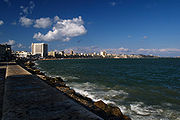
Alexandria Water Company
Encyclopedia

Alexandria
Alexandria is the second-largest city of Egypt, with a population of 4.1 million, extending about along the coast of the Mediterranean Sea in the north central part of the country; it is also the largest city lying directly on the Mediterranean coast. It is Egypt's largest seaport, serving...
, Egypt. It was originally founded in 1860 as a private company and it operated as such for more than 100 years before it was nationalized under the rule of Gamal Abdel Nasser
Gamal Abdel Nasser
Gamal Abdel Nasser Hussein was the second President of Egypt from 1956 until his death. A colonel in the Egyptian army, Nasser led the Egyptian Revolution of 1952 along with Muhammad Naguib, the first president, which overthrew the monarchy of Egypt and Sudan, and heralded a new period of...
. At that time it became the Alexandria Water General Authority (AWGA), a department of Alexandria Governorate in charge of both water supply and sewerage. In 2004, through a country-wide sector reform it became a commercially oriented company under private law. The sewerage and wastewater treatment functions were transferred to a separate company, the Alexandria General Organization for Sanitary Drainage (AGOSD), later renamed to Alexandria Sanitary and Drainage Company (ASDCO). The water utility became a company under private law, reverted to its old name AWCO and gained some operational independence. Both AWCO and ASDCO are part of the government-owned Holding Company for Water and Wastewater, which owns all utilities in Egypt. AWCO serves 4.5 million inhabitants, a number that increases to 6 million during the summer season. It receives almost all of its water through the Mahmoudiyah Canal from the Nile River. The water undergoes extensive treatment. The Alexandria water utility is one of the better-performing water service providers in Egypt.
Corporate governance and role of women. As of 2005, all eight members of AWCO’s Board of Directors, including its Chairperson, Nadia Abdou, were women, making it one of the few utilities in the Arab world run by women. The board of directors consists of five members who are AWCO staff, including its chairperson, as well as four external board members. Two external board members are appointed by the Governorate of Alexandria and two by the Holding Company for Water and Wastewater that owns AWCO and to which its Board of Directors reports. AWCO is free to use its operating budget in any way it wants. However, investment plans and any internal restructuring have to be approved by the Holding Company. Tariff increases have to be approved by the holding company, the national water regulatory agency EWRA, the Ministry of Housing, the Cabinet of Ministers, the President of the Republic and the National Assembly. Tariffs have not been increased since 1992.
Performance improvement. Between 2000 and 2004 the utility underwent a process of capacity development that manifested itself in the improvement of a number of performance indicators. For example, the utility introduced employee incentives. Field inspectors received five Egyptian pounds (about US$0.80) for each illegal connection they discovered. Also, meter readers and collectors received an incentive equal to up to 30% of their salary for exceeding monthly targets. Furthermore, water quality monitoring was improved and internal performance benchmarking as well as a financial forecasting tool were introduced. The utility increased its compliance with Egyptian drinking water standards from 90% to 100%; customer satisfaction improved from 60% to 82%; non-revenue water was reduced from 38% to 30% and bill collection efficiency increased from 59% to 81%. Technical assistance provided by various donors (USAID, GTZ and the Netherlands) helped in bringing about these improvements. It is not clear to what extent these improvements were sustained over time. According to one study, collection efficiency declined again to 65-70% in 2008.
Tariffs and cost recovery. In 2004 AWCO was the only water utility in Egypt generating revenue sufficient to cover all operation and maintenance costs and debt service. The ratio of revenues to operating costs was 150% in that year. This was achieved although water tariffs in Egypt are among the lowest in the Middle East and North Africa: For the first 10 m3 per month the residential water tariff is only Egyptian Pound 0.23/m3 (US$0.04) and for the second block until 30m3 it is Egyptian Pound 0.30/m3 (US$0,05). However, water consumption is around 300 liter/capita/day (45m3 per month for a family of five). It is thus higher than in other countries in the region or in Europe, which has a favorable impact on revenues. Sanitation tariffs are a surcharge of 35% to the water bill. Revenues for sanitation are passed on to the Alexandria Drainage Company after deduction of a service fee. ASDCO does not recover its operating costs.

Lake Mariout
Lake Mariout Buhayrat Mariyyut is a brackish lake in northern Egypt. The lake area covered 200 km² at the beginning of the 20th century, but at the beginning of the 21th century it coveres only about 50 km². It is separated from the Mediterranean Sea by the narrow isthmus on which the...
, an important fishing ground and recreational area. The discharge of domestic and industrial wastewater, as well as nutrient-rich agricultural drainage, caused the degradation of the lake’s water quality and its biodiversity. Ten wastewater treatment plants are operated by ASDCO. Their total capacity is 1.4 million m3 per day. The two main plants with a combined capacity of about 1 million m3 per day provide only primary treatment. Only one third of wastewater samples were in compliance with regulations in 2007.
Challenges and perspectives. The city of Alexandria faces several environmental challenges. One is the expected long-term rise in the level that threatens to gradually inundate the city. The Intergovernmental Panel on Climate Change
Intergovernmental Panel on Climate Change
The Intergovernmental Panel on Climate Change is a scientific intergovernmental body which provides comprehensive assessments of current scientific, technical and socio-economic information worldwide about the risk of climate change caused by human activity, its potential environmental and...
(IPCC) expects the sea level to rise by up to 59 cm in the worst of all considered scenarios by 2100.
A 0.5-m rise in sea level would lead to estimated losses of land, installations, and tourism of more than US$32.5 billion in the Governorate of Alexandria alone, cutting off the city of Alexandria from the Delta. Another challenge is a possible decrease in the flow of the Nile, which will particularly hurt Alexandria as it is the furthest downstream on the river. Such a decrease could be caused by global warming
Global warming
Global warming refers to the rising average temperature of Earth's atmosphere and oceans and its projected continuation. In the last 100 years, Earth's average surface temperature increased by about with about two thirds of the increase occurring over just the last three decades...
or by increased water use from upstream countries. One option for Alexandria to respond to the latter challenges is to embark on seawater desalination
Desalination
Desalination, desalinization, or desalinisation refers to any of several processes that remove some amount of salt and other minerals from saline water...
, which is energy-intensive and thus not only expensive, but would further contribute to greenhouse gas emissions. Under a EU-funded research project called SWITCH, a plan for Integrated Urban Water Management
Integrated urban water management
Integrated urban water management is a philosophy of varying definitions and interpretations. According to the authors of the book entitled, "Integrated Urban Water Management: Humid Tropics", IUWM is described as the practice of managing freshwater, wastewater, and storm water as components of a...
is being developed. It will assess “how Alexandria can meet a large part of its future water demand locally without depending mainly on Nile Waters”. According to the plan rainwater harvesting, stormwater usage, water reuse and water demand management could help in reaching that goal.
See also
- Water supply and sanitation in EgyptWater supply and sanitation in EgyptWater supply and sanitation in Egypt is characterized by both achievements and challenges. Among the achievements are an increase of piped water supply between 1990 and 2006 from 89% to 99% in urban areas and from 39% to 82% in rural areas despite rapid population growth; the elimination of open...
- Water resources management in modern EgyptWater resources management in modern EgyptWater resources management in modern Egypt is a complex process that involves multiple stakeholders who use water for irrigation, municipal and industrial water supply, hydropower generation and navigation. In addition, the waters of the Nile support aquatic ecosystems that are threatened by...

